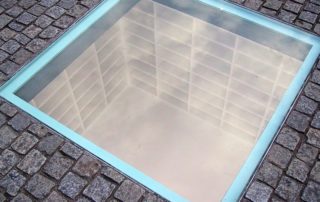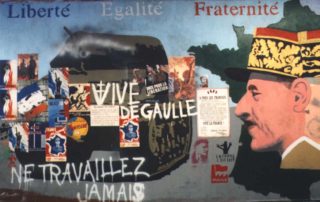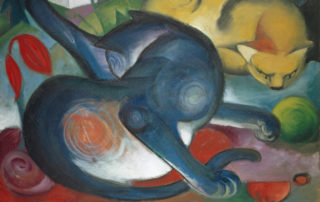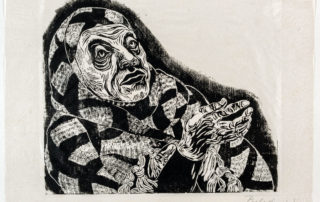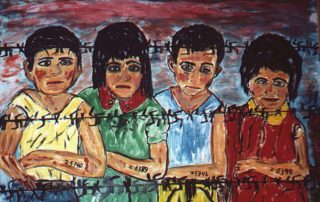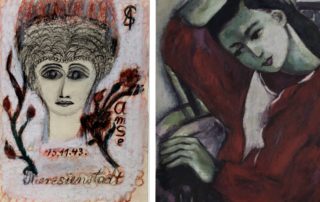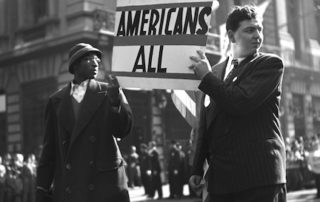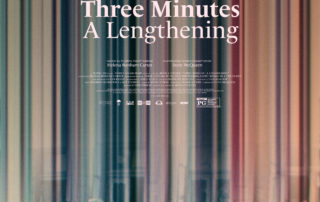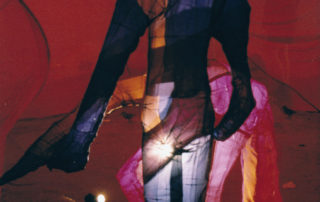Rachel Stern2023-04-17T19:19:05-04:00March 6th, 2023|Events, Lectures, Past Events|
In honor of Yom HaShoah, this talk by Georgetown University professor Ori Z Soltes focuses on three Israeli and three American familiar and unfamiliar artists working in very diverse styles and not typically thought of as focusing on the Holocaust. Each of them, however, has offered powerful reflections on the defining catastrophe of the twentieth century. Barnett Newman, the foremost verbal spokesman for the chromatic side of the abstract expressionist movement redefining American painting in the early 1950s, offers an unexpectedly intense reflection on the question of theodicy. Mordecai Ardon, in the process of assuming leadership of the Bezalel school in Jerusalem at around the same time, balances between abstraction and figuration in depicting the Nazi-engendered chaos. Yigal Tumarkin’s [...]
Rachel Stern2023-03-15T14:04:18-04:00January 24th, 2023|Events, Lectures, Past Events|
The program features a talk by Lembersky’s granddaughter, Yelena Lembersky, co-author of the recent and highly acclaimed memoir, Like a Drop of Ink in a Downpour: Memories of Soviet Russia. Yelena will be introduced by Georgetown University professor, Ori Z Soltes, who has known her for many years and has written extensively on the work of Felix Lembersky. “We are merely honest people and see what is good and bad, and we cannot be confused.” – Felix Lembersky, Leningrad, the Soviet Union, 1960 Image above: Felix Lembersky, At the Train Station, ca 1960-64. © Felix Lembersky estate Felix Lembersky (1913-1970) was a Soviet Jewish painter, teacher, theater sets designer, and an organizer of artistic groups in Leningrad and [...]
Rachel Stern2023-02-15T19:21:41-05:00January 8th, 2023|Events, Lectures, Past Events|
Inspired by a visit to his birth country in the 1990s, American artist Philip Orenstein (b. 1938) created seven murals about the French complicity in the persecution of Jews in France during World War II. At that time, the French government had not admitted it had taken part in the persecution. The murals have been shown in various galleries and museums in the United States. In 1999, William Zimmer wrote in the New York Times, “Mr. Orenstein’s method involves combining poignancy with the determination that the viewers not miss the story. To this end, Mr. Orenstein skillfully, and wittily, employs the look of today’s splashy graffiti.” The works have not yet been shown in France. Born in Paris, France, in 1938, [...]
Rachel Stern2023-02-06T07:18:23-05:00January 8th, 2023|Events, Lectures, Past Events|
The Kunstmuseum Basel’s department of classic modernism houses one of the most prestigious collections of its kind. It was in fact assembled at a comparatively late date. In the summer of 1939 — shortly before the outbreak of World War II — Georg Schmidt (1896–1966), the museum’s director at the time, managed to acquire twenty-one avant-garde masterpieces all at once. The works were among those denounced in 1937 by Nazi cultural policy as “degenerate” and forcibly removed from German museums. The Third Reich’s Ministry of Propaganda correctly assumed that a portion of such works would find buyers abroad and bring in foreign currency. In this way certain artworks deemed “internationally exploitable” reached the art market via various channels. [...]
Rachel Stern2023-03-30T06:59:22-04:00December 14th, 2022|Events, Lectures, Past Events|
The artistic work of Maria Luiko (1904-1941), born Marie Luise Kohn in Munich, is characterized by an impressive diversity. In addition to drawings, watercolors and oil paintings, she created prints using various printing processes and paper cuts, and designed book illustrations, stage sets and marionettes. Already during her studies at the local Academy of Fine Arts and her training at the School of Applied Arts she was included in exhibitions in the Munich Glass Palace (Münchner Glaspalast). Her career was brutally cut short by the Nazi regime. As a Jew, Luiko was not able to join the Reich Chamber of Fine Arts (Reichskammer der bildenden Künste), a Nazi organization founded in 1933. Without membership, she could not obtain work materials, [...]
Rachel Stern2023-03-20T06:43:11-04:00December 11th, 2022|Events, Lectures, Past Events|
Dorothy Bohm was born Dorothea Israelit in Königsberg, East Prussia (now Kaliningrad, Russia) in 1924 into an assimilated, affluent and cultured Jewish milieu. In 1932 her father chose to move the family to Memel (now Klaipeda) in Lithuania, but following the Nazi occupation of Memelland in March 1939, her parents decided to send their daughter, aged 14, to the safety of England, where she arrived in June 1939. She wasn’t to see her parents and sister again for over twenty years. Image above (appears as detail): Dorothy Bohm, Venice Carnival, 1987 © Dorothy Bohm Archive Dorothy Bohm, Self-Portrait, 1942, age 18. © Dorothy Bohm Archive Dorothy Bohm, Ascona, 1948. © Dorothy Bohm Archive [...]
Rachel Stern2023-02-01T06:15:59-05:00December 1st, 2022|Events, Lectures, Past Events|
In honor of UN Holocaust Remembrance Day, Hilary Helstein, director of the award-winning documentary "As Seen Through These Eyes" spoke with Rachel Stern, director and CEO of the Fritz Ascher Society New York, about the making of her documentary. As poet Maya Angelou narrates this powerful documentary, she reveals the story of a brave group of people who fought Hitler with the only weapons they had: charcoal, pencil stubs, shreds of paper and memories etched in their minds. These artists took their fate into their own hands to make a compelling statement about the human spirit, enduring against unimaginable odds. Featuring interviews with Simon Wiesenthal as he talks about his art, never before appearing in a film, [...]
Rachel Stern2022-11-24T05:24:57-05:00November 10th, 2022|Events, Past Events|
In the aftermath of the Holocaust, the unprecedented destruction and plight of survivors prompts the unthinkable - German and Jewish leaders meet in secret to grapple with the first reparations in history, resulting in the groundbreaking Luxembourg Agreements of 1952. Screening followed by Q+A with Gideon Taylor and Karen Heilig, from the Conference on Jewish Material Claims Against Germany. Watch the Trailer: SCREENINGS In the aftermath of the Holocaust, German and Jewish leaders met in secret to negotiate the unthinkable – compensation for the survivors of the largest mass genocide in history. Survivors were in urgent need of help, but how could reparations be determined for the unprecedented destruction [...]
Rachel Stern2023-02-26T09:25:37-05:00November 7th, 2022|Events, Lectures, Past Events|
Erna Pinner, Rosy Lilienfeld, Amalie Seckbach, and Ruth Cahn were among the first women artists in Frankfurt to enjoy professional success. Throughout the Roaring Twenties, these four Jewish women left their mark on Frankfurt’s art scene, published and exhibited internationally, cultivated a cosmopolitan lifestyle, and competed with their male colleagues. When the National Socialists seized power, their careers came to an abrupt end. From then on, they were persecuted as Jews and their works ostracized; later, after the end of World War II, they were largely forgotten. Now, “Back into the Light” is at long last bringing them back to the public eye. The departure point is an article by art historian Sascha Schwabacher, published May 1935 [...]
Rachel Stern2022-11-02T14:42:41-04:00August 9th, 2022|Events, Lectures, Past Events|
Fred Stein lived through some of the greatest upheavals of the 20th century. He escaped Nazi Germany; he mingled with Chagall and Brecht in Paris; and he debated with Einstein in New York. He was a scholar, a refugee, and an idealist. But above all, he was a photographer. An early innovator of hand-held street photography in 1930s France and 1940s New York, his images are sophisticated, beautiful, and touching; his portraits include some of the most important people of the mid-20th century, like Albert Einstein. Image above: Fred Stein, Americans All, New York 1943 © Fred Stein Archive Fred Stein, Paris Evening, Paris 1934 © Fred Stein Archive [...]
Rachel Stern2022-08-26T05:49:55-04:00July 14th, 2022|Events, Lectures, Past Events|
"'Three Minutes' is more than a documentary about the Holocaust — it is an investigative drama, a meditation on the ethics of moving images and a ghost story about people who might be forgotten should we take those images for granted." Beatrice Loayza, The New York Times (Critic's Pick) [FULL ARTICLE HERE] Thank you to everyone who made the sneak screening such a huge success! Catch a screening of the film: NOW SCREENING NATIONWIDE - FIND YOUR CITY HERE Three minutes of footage of a 16mm home movie found in an attic in South Florida, shot by David Kurtz in 1938, are the only moving images remaining of the Jewish inhabitants of Nasielsk, Poland before [...]
Rachel Stern2022-10-03T13:54:27-04:00June 24th, 2022|Events, Lectures, Past Events|
Mimi Gross is the daughter of well-known sculptor Chaim Gross (1902–1991). She grew up to become an artist and one obvious question one might ask is how her work was influenced by and/or diverged from her father's work. But both Chaim and his wife Renee were immigrants--so New York City-born Mimi grew up as an American in an immigrant household, which might raise the question: were there issues derived from the particulars of her growing up that affected her and her art--and might one imagine the curve of her life as different in a non-immigrant context, or a context experienced at a different time in American and world history? These and other questions are discussed in a dialogue between Mimi Gross and [...]


